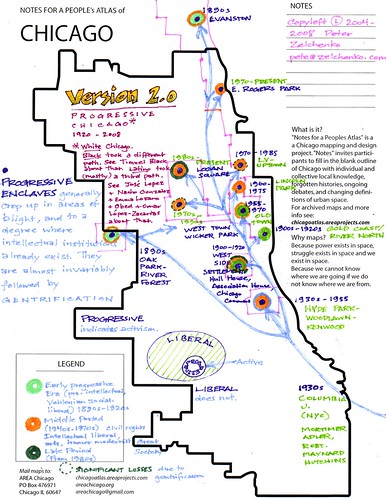
The Corner: 23rd and Union stood for a little over a year at a Seattle intersection near the geographic center of the city in the heart of the Central District, the city's historic African American neighborhood as seen in segregation maps from the 1960s. The installation was an experiment in community storytelling and dialogue using public art as the spark, inspiring neighbors to react, sing, remember, speak and listen to each other across chasms. They called comments and reflections into a voice recording which was then uploaded and curated onto a companion web site.
Created by KUOW public radio producer Jenny Asarnow, the project was well received in the neighborhood. Asarnow said "I felt like it had been an outlet for people, for a large number of people. They had been able to speak their minds and be creative and listen to people from their own community who they might not have heard from otherwise."
Slide show of the installation
Last Monday, the installation was abruptly dismantled after police told the owner of the vacant lot and Asarnow that they had received complaints about one of the photographs in particular, shown above. Read the full story here. It's unclear if it the police themselves were objecting to this image of a black man with a criminal record, or if they were merely passing on complaints of anonymous neighbors. Either way, the police clearly wanted the installation taken down, ending the community dialogue on a one-sided note. The phone number connected to the site is no longer accepting messages, unfortunately cutting off the possibility of a real community response.
The installation may be resurrected as an exhibit at the Northwest African American Museum, but it will be removed from the corner that gave it significance and life. The location itself was an integral part of the piece, evoking memories and creating interactions that would have been impossible otherwise, giving "site specific" new meaning.
Preserving "The Corner" in place and time, making sure events like these don't slowly fade away as a footnote or a fuzzy memory, is one idea behind "People's Atlas" project. Creating a People's Atlas of Seattle could be an archive for the history and importance of place that "The Corner" uncovered.

“Notes for a Peoples Atlas” is a multi-city, participatory mapping and design project that began under the sponsorship of AREA Chicago in 2005 with a Chicago-based project, and has now traveled to Zagreb, Croatia and Syracuse, NY. “Notes” invites participants to fill in the blank outline of the political border of their city or region with individual and collective local knowledge, forgotten histories, ongoing debates, and changing definitions of urban space. “Notes” generates dialogue and open-ended imagining about urban space and history, taking seriously the expertise and ideas of “nonspecialist” community members. When archived, it presents information in a form that is accessible, well-designed, and visually rich.
i love this post. it addresses for me the issue of building community through art and how that might look.
ReplyDeleteThe police response is reminding me of this John Berger quote:
ReplyDeleteI can't tell you what art does and how it does it, but I know that art has often judged the judges, pleaded revenge to the innocent and shown to the future what the past has suffered, so that it has never been forgotten. I know too that the powerful fear art, whatever its form, when it does this, and that amongst the people such art sometimes runs like a rumour and a legend because it makes sense of what life's brutalities cannot, a sense that unites us, for it is inseparable from a justice at last. Art, when it functions like this, becomes a meeting-place of the invisible, the irreducible, the enduring, guts and honour.